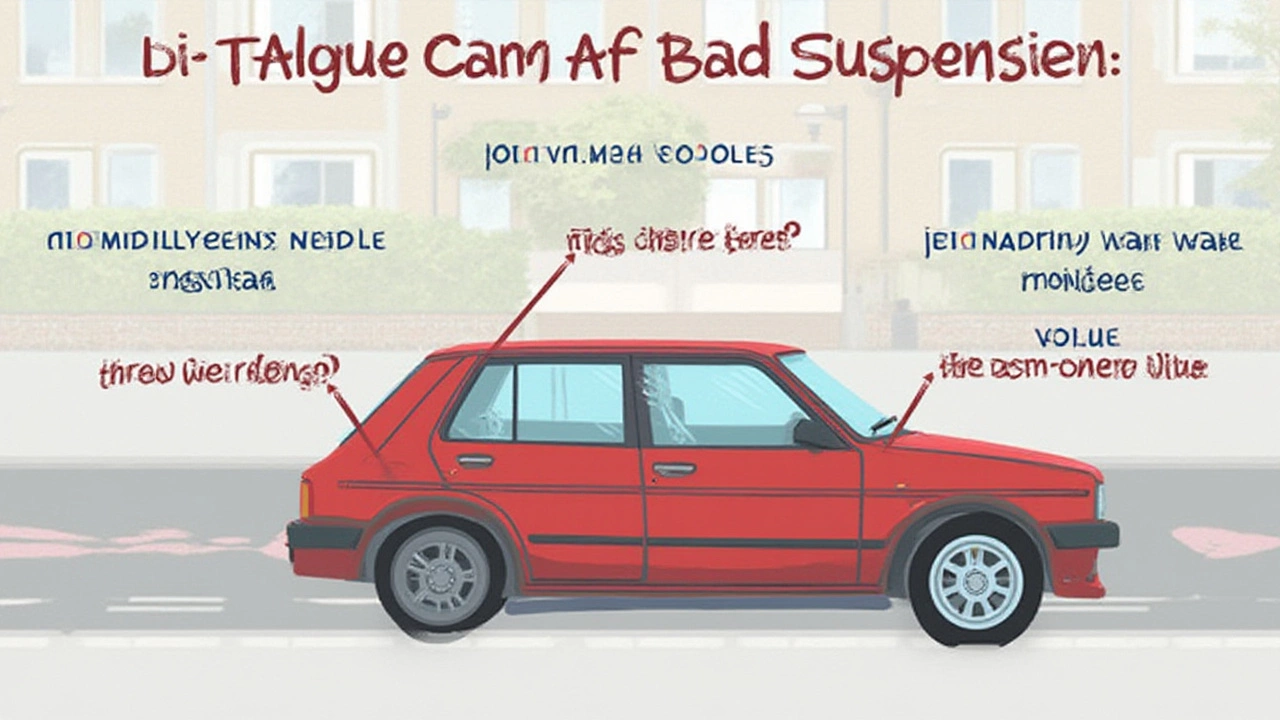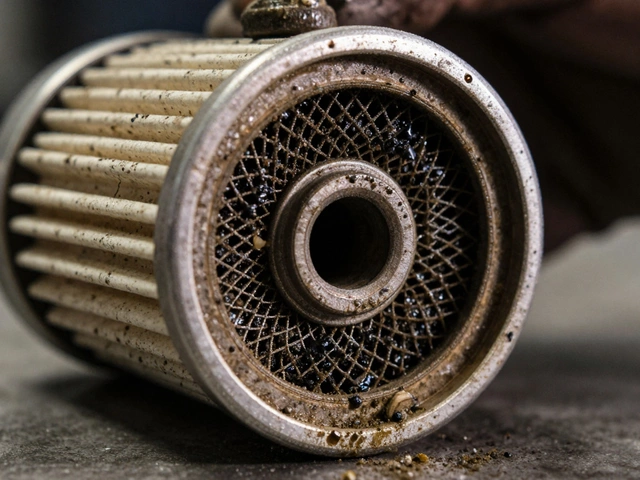You ever hear that weird clunk every time you hit a pothole, then find yourself asking, “Can I drive with bad suspension?” Maybe you’ve ignored it, blaming the bumpy ride on rough roads. But your car’s suspension isn’t just about a smooth ride—it’s the invisible force keeping your four wheels safe, especially when life throws you a curve (or a speed bump the size of Mount Everest). People try to save a buck postponing repairs, but driving on bad suspension isn’t just risky—it messes with your wallet, your safety, and even how much you enjoy road trips with the family. Not convinced? Let’s dig deep into what really happens when you roll the dice on a rough ride.
What Suspension Does and Why It Matters for Everyday Driving
Think of your car's suspension as the unsung hero. It’s a collection of springs, shocks, struts, and control arms that absorb impacts, keep the tires in contact with the road, and prevent you from feeling every pebble or crack under your wheels. Most people only notice it when something goes wrong. But here’s the kicker—the suspension isn’t just about comfort. It's directly tied to steering control and braking performance.
Imagine going over a speed bump. With a healthy suspension, your tires stay glued to the pavement, you maintain control, and nothing rattles out of place. Once suspension parts wear out—think leaky shocks, saggy springs, bent control arms—those same bumps send your car bouncing, lurching, or even making those scary knocking noises. Suddenly, your tires aren’t gripping the road like they should. That means longer stopping distances, rough steering, and a whole lot of squirming if you need to swerve last minute. According to recent vehicle safety data, cars with worn suspensions can require up to 20% longer to stop in wet conditions compared to those in good repair. It’s not just about being uncomfortable; it’s about being unsafe.
Tough winters, hauling heavy loads, and just plain old time wear out these parts faster, too. And if you commute in a city with crater-sized potholes—hello Chicago and New York, looking at you—expect your suspension to work even harder. Mechanics see cars with blown struts and snapped sway bars nearly every week. At my local garage, a guy rolled in with his SUV leaning hard to one side, like a dog chasing its tail. Turns out one spring had completely collapsed from years of ignored warning signs and overloading. The fix wasn’t just expensive, it wrecked his tire alignment and killed a nearly new set of tires. That’s how crucial your suspension really is.
Warning Signs Your Suspension Might Be Failing
So, how do you spot the problem before it spikes your nerves—or your repair bill? Bad suspension isn’t shy about making itself known. The most common red flags are easy to notice if you know what to look for. First, there’s the obvious bouncing. You hit a bump, and your car keeps bouncing like a trampoline. That’s a classic sign that your shocks or struts are done for. Then comes the “pulling” feeling. If your car veers to one side even with your hands steady on the wheel, bad suspension could be the culprit, not just wheel alignment.
Other telltale hints include squeaks and clunks—especially when cornering or going over speed bumps. If you start hearing loud banging sounds, it might mean metal parts have started rubbing together. Don’t tune it out with the radio. Your steering wheel might fight back or feel loose—think of it like trying to steer a boat that just won’t cooperate. You might also notice one side of your car sitting lower than the other. Take a step back and eyeball it. If you can see your car sagging, that’s a dead giveaway.
Uneven tire wear is another loud-and-clear message. Worn suspension parts don’t hold your wheels at the right angles, so your tires grab pavement in weird ways, leading to bald spots. Pro tip: slide your hand across the tread—if it feels scalloped or lumpy, suspension trouble could be the reason. Soggy, oily marks down the shocks or struts? That’s leaking fluid, a sign the part isn’t absorbing impacts. Even brake dives—where your front end drops hard when you stop—point fingers at worn suspension. Trust your gut: if your car suddenly handles worse, there’s usually a reason, and more often than not, it’s your suspension waving the biggest red flag.

What Happens If You Ignore Bad Suspension?
By now, you’d assume nobody would risk driving far with bad suspension. But walk through any busy mechanic’s shop and you’ll see at least one car that makes you wonder how it made it out of the driveway. What happens long-term if you roll the dice? Besides the constant discomfort, you’re risking a cascade of other problems.
First off, your stopping distance gets worse—sometimes a lot worse. If your car can’t keep its wheels pressed firmly against the road, it can skid or slide when you slam the brakes. According to crash data from the National Highway Traffic Safety Administration, faulty suspension factors into thousands of accidents every year—especially in rain or snow when grip is everything. Take a look at some data in the table below:
| Condition | Braking Distance (ft) | Accident Rate Increase |
|---|---|---|
| Healthy Suspension (Wet Road, 60mph) | 220 | -- |
| Bad Suspension (Wet Road, 60mph) | 264 | +18% |
| Healthy Suspension (Dry Road, 60mph) | 180 | -- |
| Bad Suspension (Dry Road, 60mph) | 206 | +13% |
It doesn’t stop there. Bad suspension changes how your tires touch the road, so they wear out way faster. You could be looking at a set of tires every six months instead of every two years. That’s money down the drain. Maybe the most dangerous bit is how unpredictable your car becomes. Enter a tight corner, swerve to miss a squirrel, or brake hard, and your car could bounce, sway, or roll—a heart-stopping moment no one wants to experience. Insurance claims? Fewer are as frustrating as “unexpected loss of control.” If you’re unlucky, that loose suspension part could break completely and send your car bottoming out or worse—cause you to drift into another lane or off the road.
I’ve heard from mechanics who say more than half of customers with bad suspension issues ignored noise and handling problems for months, convinced they could “wait it out.” Yikes. Small problems like worn bushings or leaky shocks quickly snowball. That means more expensive repairs. And trust me, nobody wants to pay for both suspension AND tires, steering, or bodywork because they waited too long.
Can You Keep Driving With Bad Suspension? Here’s the Real Answer
The blunt answer: you shouldn’t. Technically, your car will move. Most cars with worn shocks, saggy springs, or loose control arms can limp along, especially if you stick to city speeds and baby the car. I've limped my beat-up Camry back from work with a blown shock before, so I get the temptation. But each time you drive, you’re multiplying the risk—not just for yourself, but for anyone sharing the road with you.
Emergency situations reveal just how sketchy it gets. Try making a quick lane change with bad suspension—your car leans, wobbles, and it might even give you a fishtail or a wild shudder. Plus, if one part is bad, the damage spreads. That’s how you end up with snapped sway bars or torn control arm bushings, chewing through other parts in the suspension system. Your alignment heads out of whack, too. That means every mile you drive, your tires wear even faster and your fuel economy drops. You’ll start to feel every crack and bump, which isn’t just annoying—it’s exhausting, especially on long trips. Olivia once compared a ride in our old car after the struts went to riding a mechanical bull. Not the sort of adventure you want from your family sedan.
If budget is tight, at least get an inspection fast. Some shops offer free or low-cost checks. If just one part is failing—say, a shock or a spring—you can sometimes replace it without redoing everything. But driving while you wait for repairs should be a worst-case option. If the steering side of your suspension (like tie rod ends or ball joints) is shot, your car can lose control at any moment—no warning, no second chance. In that case, park it and call a tow.
- Avoid highways or high speeds—short city hops are safer if you absolutely must drive.
- Slow way down for bumps, and don’t load your car with heavy stuff.
- Get repairs lined up as soon as you can. Prices jump if more parts fail.
- Watch out for changes—if the noise gets louder or the car feels worse, park it.
You don’t need to be a pro to see suspension problems are a snowball that grows with every mile. If you want to avoid a massive repair bill (or worse, a crash), honesty is the best policy—listen to the noises and don’t brush off weird handling.

How to Catch Suspension Trouble Early and Save Money
Catching and fixing suspension problems early can save your bacon, your bank account, and your sanity. The trick is staying alert to changes, especially after 60,000-90,000 miles on the odometer. Check your owner’s manual—most recommend inspections every 15,000 miles or once a year. But most folks wait until they hear knocking or feel rear-end sag. Here’s some down-to-earth tips:
- Inspect your shocks and struts. Pop the hood or look under the rear—any leaking oil or dented housing is bad news.
- Push down on each corner of your car. If it bounces more than twice, the shocks or struts are worn.
- Glance at your tires when filling up on gas. Uneven wear, bald patches, or a lumpy feel often means suspension is to blame.
- Listen during test drives. Creaks, sharp clunks, rattles, and a heavy pulling sensation are warning bells you shouldn’t tune out.
- Notice handling. If your car used to feel “tight” and now floats, sways, or seems out of control, don’t let it slide.
I once skipped an annual check, thinking I could save a few bucks. That decision led to cracked strut mounts and ruined tires. My mechanic said I could've avoided most of the repair costs with a basic inspection. Most shops charge $50-$100 for a full suspension check, and some even roll that fee into the repair price if you go ahead. It's a lot cheaper than risking a major repair or accident.
Suspension parts might sound intimidating, but most repairs aren’t rocket science—or wallet-busters—if you catch them before things spiral. Replacing shocks or bushings can often be done in a weekend, especially if you’re handy with a wrench, but don’t hesitate to get pro help. If you’re not sure, most mechanics are happy to do a walk-around with you, pointing out what’s normal and what needs help. When in doubt, trust your instincts, or in my case, Olivia’s—she hears every odd noise and bug me until I check it out. That sort of stubbornness saves a lot of headaches.
So don’t treat your suspension like an afterthought. Whether you’re cruising the boulevard or packing up the kids for a cross-country trip, a little attention now keeps you rolling strong—and keeps your road trip memories about the fun, not about car trouble on the shoulder.






